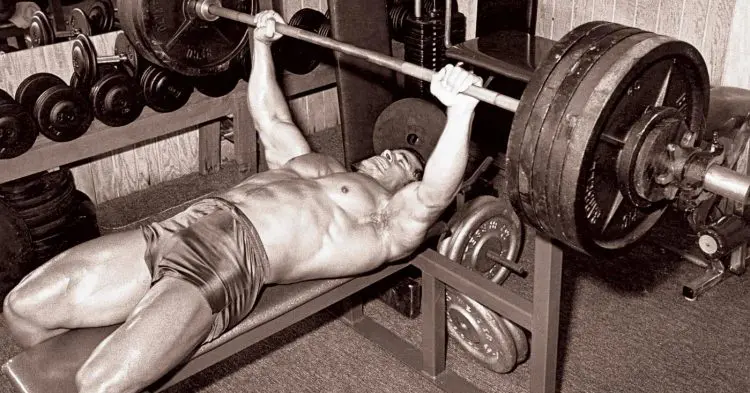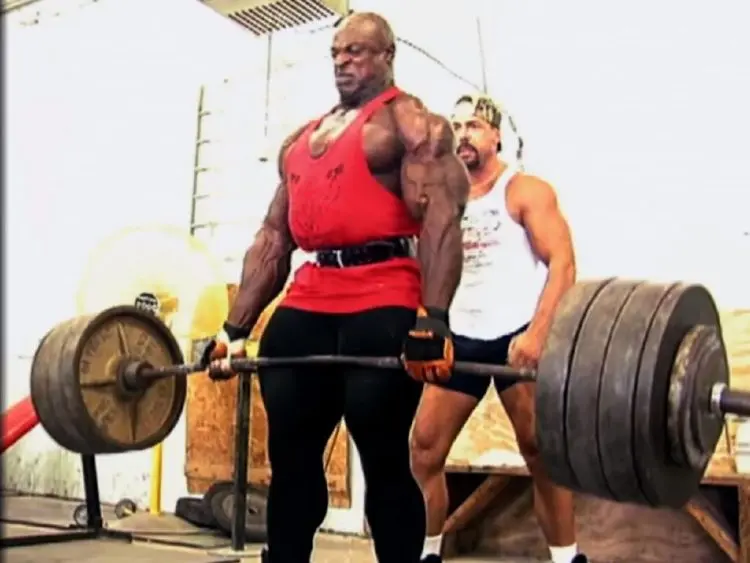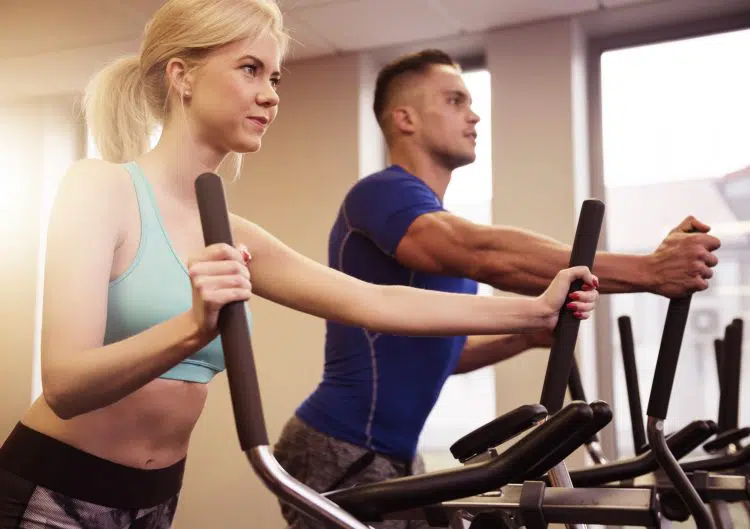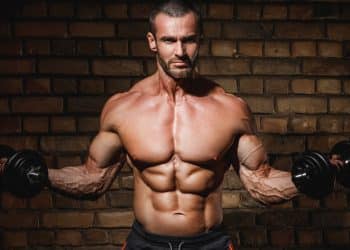Most exercisers want to build or maintain muscle while burning fat. Invariably, this means doing cardio after lifting weights or doing cardio and strength training on separate days.
While such an approach can (and frequently does) work, it’s not exactly time-efficient. And do you really want to drag yourself through a 30-minute cardio workout after you’ve just hammered your muscles into submission?
Probably not!
The good news is that there’s an alternative to doing cardio after weights or on your rest days – upper lower body/upper body supersets.
Like all supersets, this training method involves doing two exercises back to back. However, this strategy is not just for hypertrophy and time-efficiency but for torching fat, too.
In this article, we reveal the theory behind this simple but effective workout method and provide you with a sample workout to try.
Level Up Your Fitness: Join our 💪 strong community in Fitness Volt Newsletter. Get daily inspiration, expert-backed workouts, nutrition tips, the latest in strength sports, and the support you need to reach your goals. Subscribe for free!
Lower Body/Upper Body Supersets Basics
Most exercisers are more than familiar with supersets but, in case you missed the memo, let’s revisit this popular training method so that everyone understands how they work!
A superset is two exercises done back to back. In supersets, you do the first exercise and then quickly move to and perform the second exercise. After completing the second exercise, you rest 1-2 minutes and then repeat the pairing the specified number of times, which is usually 2-4.
There are several different types of supersets, including:
- Agonist supersets
- Agonist-antagonist supersets
- Pre-exhaust supersets
- Post-exhaust supersets
- Strength and power supersets
All of these types of supersets have benefits, and especially good for building muscle mass. Still, when it comes to fat burning, lower body/upper body supersets are arguably the best choice.
What makes lower body/upper body supersets so darn effective?
Good question!
When you do an exercise, oxygenated blood is preferentially pumped to the muscle or muscle groups doing the work. That’s why non-cardio workouts like strength training increase your heart rate.
Normally, after doing a set of an exercise, you rest, and your heart rate starts to return to normal.
However, with lower body/upper body supersets, not only is your heart rate elevated for longer, your heart has to work extra hard to pump blood to an entirely different part of your body.
Needless to say, all this “blood shunting” increases your energy expenditure, leading to faster fat loss. In addition, doing lower body/upper body supersets means you’ll be working more muscle groups at the same time, which also increases the number of calories burned per workout.
Finally, lower body/upper body supersets save time, as you won’t spend as much of your workout resting. This means you can do more work per training session, further increasing the energy cost of your workouts. This is called increasing the density of a workout.
Lower Body-Upper Body Superset Dos and Don’ts
In simple terms, lower body/upper body supersets turn your strength workout into high-intensity interval training. HIIT is arguably one of the best fat-burning workouts around.
Examples of lower body/upper body supersets include:
Or:
- Leg press
- Pull-ups
Or:
Ideally, to make them as effective as possible, the exercises in your lower body/upper body supersets should be close together so you can move from one to the next without delay. So, it may be necessary to select your exercise pairs based on where they are in your gym or your ability to place training equipment close together.
One easy way to do this is to make the upper body exercise a freeweight or bodyweight exercise. That way, you can set it up and do it right next to your chosen lower-body movement.
While you can pair almost any lower body-upper body exercise, make sure the performance of the first exercise won’t impede the performance of the second.
For example, pairing deadlifts and bent-over rows could be problematic because your lower back is strongly involved in both exercises. As such, you may find that you are unable to do the bent-over row correctly and doing deadlifts first could even increase your risk of injury.
So, avoid overlapping muscle groups to ensure you can do both exercises with sufficient intensity.
Lower Body/Upper Body Supersets Workout
While there is nothing to stop you from writing your own lower body/upper body supersets, to save you the trouble, we have created a full-body workout for you to try.
Do this workout 2-3 times a week on non-consecutive days, e.g., Monday and Thursday, or Monday, Wednesday, and Friday.
Use moderate weights so that, for the first superset, you finish with 2-3 reps left in the tank. You’ll get closer to failure as you do each superset.
Finally, remember to warm up before you work out. This workout involves all your major muscles, so make sure you do a full-body warm-up too. Start off with 5-10 minutes of easy cardio, followed by a few dynamic mobility and flexibility exercises for your major muscles and joints.
| Lower Body/Upper Body Superset Workout | ||||
| # | Exercise | Sets | Reps | Recovery |
| 1a | Goblet squat | 2-4 | 12-15 | No rest between paired exercises,
60-90 seconds between supersets |
| 1b | Lat pulldowns | 8-12 | ||
| 2a | Romanian deadlift | 2-4 | 12-15 | |
| 2b | Dumbbell bench press | 8-12 | ||
| 3a | Step-through lunges | 2-4 | 8-12 per leg | |
| 3b | Chest-supported row | 8-12 | ||
| 4a | Barbell hip thrust | 2-4 | 12-15 | |
| 4b | Seesaw shoulder press | 8-12 per arm | ||
The letters a) and b) designate a superset. So, do exercise 1a immediately followed by 1b. Rest the allotted time and then repeat the pairing. On completion, move on to the next pair of exercises, i.e., 2a and 2b.
Got it? Good!
Exercise Descriptions
Get the most from this (and every other) workout by doing each exercise correctly. Not only will this make your training more productive, but it’ll be safer too. Bad exercise technique? Just say no!
1. Goblet squat
Goblet squats are the perfect lower body building, fat-burning exercise. They’re safe to do to failure, and all you need is a single kettlebell or dumbbell – no squat rack required. Best of all, goblet squats teach and reinforce good squatting mechanics, making them an excellent choice for all levels of exerciser.
Level Up Your Fitness: Join our 💪 strong community in Fitness Volt Newsletter. Get daily inspiration, expert-backed workouts, nutrition tips, the latest in strength sports, and the support you need to reach your goals. Subscribe for free!
Check out our in-depth guide to goblet squats here.
2. Lat pulldowns
Lat pulldowns are a time-honored upper back exercise that also works your biceps. Workout purists may prefer pull-ups and chin-ups, but using a machine means you can adjust the weight to keep you in the 8-12 rep “sweet spot” of this workout. Use your preferred grip, i.e., overhand, underhand, neutral (narrow), or neutral (shoulder-width).
Read more about lat pulldowns here.
3. Romanian deadlift
While there is only a causal link between this type of deadlift and the country of its name, Romanian deadlifts (RDLs) are an almost unbeatable posterior chain exercise. You can do RDLs with a barbell or dumbbells as preferred. Just take care not to round your lower back, as doing so will increase your risk of injury.
4. Dumbbell bench press
The barbell bench press might be the world’s favorite exercise, but the dumbbell version may be better for some lifters. For a start, you can use a larger range of motion, increasing hypertrophy. Also, you’ll have to work a little harder to stabilize two weights instead of one, increasing muscle engagement.
Finally, dumbbell bench presses are often more shoulder-friendly than the barbell variation. All that said, if you prefer barbell bench presses, feel free to do them instead.
Read more about dumbbell bench presses here.
5. Step-through lunges
Unable to decide between backward or forward lunges? Then don’t! Step-through lunges combine both types to work your front and rear thighs and glutes equally. They’re also good for developing better hip mobility, balance, and coordination. Do them with or without dumbbells as required.
How to do it:
- Stand with your feet together, arms by your sides. Pull your shoulders down and back, brace your core, and look straight ahead.
- Take a large step forward, bend your legs, and lower your rear knee down to within an inch of the floor.
- Push off your front leg and straight back into a reverse lunge. Again, bend your legs and lower your rear knee to within an inch of the floor.
- Continue alternating between forward and reverse lunges for the required number of reps and then switch legs.
- Do the same number of reps with the opposite leading leg.
6. Chest-supported row
Chest supported rows, also called incline rows, provide your lower back with plenty of support, so you are free to focus on working your lats and biceps. You can do this exercise with dumbbells or a barbell. However, the dumbbell variation usually allows for a greater range of motion.
How to do it:
- Set an incline bench to a 30 to 45-degree angle. Lie face down on the bench with your head uppermost. Hold the weight(s) in your hands and pull your shoulders down and back.
- Without lifting your chest or bending your wrists, lead with your elbows and row the dumbbells into the side of your ribs (or the barbell into your chest).
- Extend your arms and repeat.
7. Barbell hip thrust
Barbell hip thrusts work your glutes and legs without punishing your lower back, making them the ideal last lower body exercise for this workout. The muscles involved are pretty powerful, so don’t be afraid to use moderate to heavy weights for this exercise.
Learn how to do barbell hip thrusts here.
8. Seesaw shoulder press
Seesaw shoulder presses work your deltoids, triceps, and core simultaneously, making them an excellent calorie burner and also very time efficient. This is your last exercise so keep working right to the end.
Try not to use your legs to help push the weight up, except at the very end of your last set, when a little leg drive may help you crank out an extra couple of reps.
How to do it:
- Hold a dumbbell in each hand and stand with your feet shoulder-width apart. Bend your knees slightly, brace your core, and pull your shoulders down and back. Raise the dumbbells to your shoulders, palms turned inward. Press one dumbbell above your head to arms’ length.
- Lower the dumbbell to your shoulder while simultaneously pressing the other weight up.
- Continue alternating arms for the duration of your set.
- Increase core activation by leaning slightly to the side as you press the dumbbells overhead.
Lower Body/Upper Body Supersets Workout FAQs
Got a question about this workout? We’ve got answers!
Can I change the exercises?
You bet! However, make sure you use similar movements. For example, you could do push-ups instead of dumbbell bench presses or walking lunges instead of step-through lunges. Don’t do something like biceps curls instead of lat pulldowns – that’s too dissimilar to work. Use big, compound exercises and not isolation exercises to get the most from this workout.
If you want to create your own lower body/upper body superset workout, just plug the appropriate exercises into the following template:
| # | Movement | Example exercises |
| 1a | Compound leg – knee dominant | Squat, leg press, hack squat, lunge |
| 1b | Horizontal push | Bench press, dip, push-ups, chest press |
| 2a | Compound leg – hip dominant | RDL, deadlift, good morning, hip thrust |
| 2b | Horizontal pull | Seated row, row machine, 1-arm row |
| 3a | Compound leg – knee dominant | Squat, leg press, hack squat, lunge |
| 3b | Vertical push | Overhead barbell or dumbbell press |
| 4a | Compound leg – hip dominant | RDL, deadlift, good morning, hip thrust |
| 4b | Vertical pull | Pull-up, chin-up, pulldown |
What about core training?
There is no direct core training in this workout. However, your core is involved indirectly in many of the exercises. Core exercises generally lower your heart rate and burn very few calories, which is why we’ve not included any.
But, if you are keen to work your core, add this five-minute plank program to the end of this workout.
What diet should I follow to burn more fat on this workout?
It’s beyond the scope of this article to give you a fat loss diet to follow. Instead, follow these guidelines:
- Create a 300-500 calorie deficit
- Aim to lose 1-2 pounds per week
- Eat one gram of protein per pound of bodyweight
- Consume more fibrous carbs, i.e., vegetables, fruits, and whole grains
- Eat mostly fresh, natural foods
- Limit your intake of processed foods, sugar, and alcohol
- Drink more water than coffee, soda, etc.
- Don’t follow a fad, starvation diet that you can’t maintain for the foreseeable future
Check out this in-depth guide on eating for leanness.
Why are my muscles so sore?
A new workout is often accompanied by muscle soreness. This is your body’s way of telling you that you’re doing more than it’s used to. Muscle soreness is caused by various factors, including muscle microtrauma, the accumulation of metabolic waste products, oxygen debt, and inflammation.
You can minimize muscle soreness by always warming up before you work out, cooling down with some light cardio and stretching at the end of each workout, and staying active between workouts, e.g., by walking more and sitting less.
A little soreness is to be expected, but if it’s debilitating, it may be a sign you are pushing yourself too hard and need to lower your training volume or intensity.
Can I still do cardio?
This workout is designed to eliminate the need to do lots of cardio for fat loss. Each workout should provide the fat-burning benefits of cardio without resorting to hitting the treadmill or sitting on a bike.
That said, if you enjoy cardio and still want to do some, there is no reason not to include it in your weekly schedule.
Do some low-intensity steady-state (LISS) or high-intensity interval training (HIIT)between your lower body/upper body superset workouts if you wish, but it’s not essential. If you feel you NEED to do more cardio to burn fat, it could be that you are eating too much, and your diet needs an overhaul.
Wrapping Up
While lower body/upper body supersets are not exactly new, they are less common than other types of supersets. That’s a shame because, when it comes to using strength training to burn fat and get lean, they’re VERY hard to beat!
There is nothing wrong with doing cardio, either LISS or HIIT, after lifting weights. Still, it does mean you’ll probably need to spend 90 minutes or more at the gym, and that’s not always desirable or practical.
Lower body/upper body supersets push your heart and breathing rate up, increasing your caloric expenditure. Also, by saving time, they allow you to cram more work into each gym session, burning even more calories.
So, if you want to burn fat and build or maintain muscle mass while cutting down on how long and how often you work out, lower body/upper body supersets could be the workout plan you’ve been looking for.












